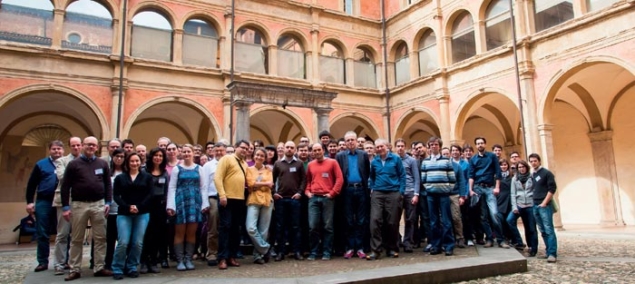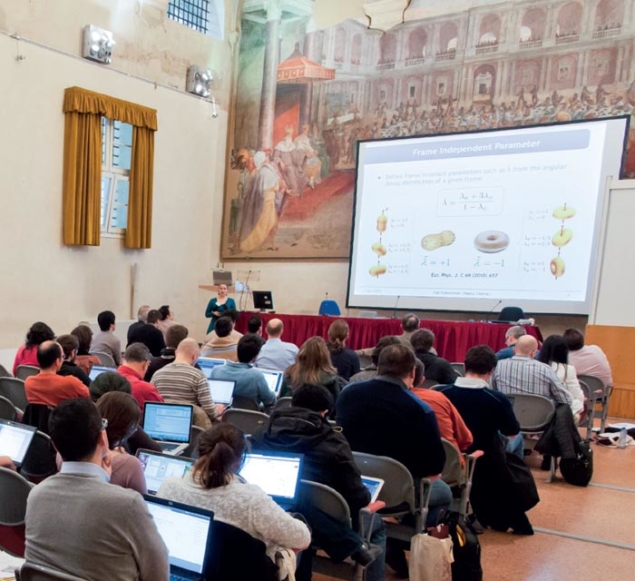The latest news from the Beauty 2013 international conference.

Image credit: Riccardo Serra.
Some 100 physicists, including experts from all around the world, converged on Bologna on 8–12 April for the 14th International Conference on B Physics at Hadron Machines (Beauty 2013). Hosted by the Istituto Nazionale di Fisica Nucleare (INFN) and by the local physics department, the meeting took place in the prestigious Giorgio Prodi lecture hall, at the heart of a magnificent complex in the city centre.
The Beauty conference series aims to review results in the field of heavy-flavour physics and address the physics potential of existing and upcoming B-physics experiments. The major goal of this research at the high-precision frontier is to perform stringent tests of the flavour structure of the Standard Model and search for new physics, where strongly suppressed, “rare” decays and the phenomenon of CP violation – i.e. the non-invariance of weak interactions under combined charge-conjugation (C) and parity (P) transformations – play central roles. New particles may manifest themselves in the corresponding observables through their contributions to loop processes and may lead to flavour-changing neutral currents that are forbidden at tree level in the Standard Model. These studies are complementary to research at the high-energy frontier conducted by the general-purpose experiments ATLAS and CMS at the LHC, which aim to produce and detect new particles directly.
During the past decade e+e– B factories have been the main pioneers in the field of B physics, complemented by the CDF and DØ experiments at the Tevatron, which made giant leaps in the exploration of decays of the Bs0 meson. Exploiting the highly successful operation of the LHC, the experimental field of quark-flavour physics is being advanced by the purpose-built LHCb experiment, as well as by ATLAS and CMS. In the coming years, a new e+e– machine will join the B-physics programme, following the upgrade of the KEKB collider in Japan and the Belle detector there. This field of research will therefore continue to be lively for many years, with the exciting perspective of reaching the ultimate precision in various key measurements.
The participants at Beauty 2013 were treated to reports on a variety of impressive new results. CP violation has recently been established by LHCb in the Bs0 system with a significance exceeding 5σ by means of the Bs0 → K–π+ channel. The ATLAS collaboration reported its first flavour-tagged study of Bs0 → J/ψφ decays and the corresponding result for the Bs0 – Bs0 mixing phase φs, which is in agreement with previous LHCb analyses. LHCb presented the first combination of several measurements of the angle γ of the unitarity triangle from pure tree-level decays. In the field of charm physics, a new LHCb analysis of the difference of the CP asymmetries in the D0 → π+π– and D0 → K+K– channels does not support previous measurements that pointed towards a surprisingly large asymmetry. The CDF collaboration reported on the observation of D0 – D0 mixing, confirming the previous measurement by LHCb. Concerning the exploration of rare decays, LHCb presented the first angular analysis of Bs0 → φμ+μ–.
Di-muons and more
In addition to this selection of highlights, one of the most prominent and rare B decays, the Bs0 → μ+μ– channel, was the focus of various discussions and presentations at Beauty 2013. In the Standard Model, this decay originates from quantum-loop effects and is strongly suppressed. Recently, LHCb was able, for the first time, to observe evidence of Bs0 → μ+μ– at the 3.5σ level. The reported (time-integrated) branching ratio of 3.2+1.5–1.2 × 10–9 agrees with the Standard-Model prediction. Although the current experimental error is still large, this measurement places important constraints on physics beyond the Standard Model. It will be interesting to monitor future experimental progress.

Image credit: R Serra.
With recently proposed new observables complementing the branching ratio, the measurement of Bs0 → μ+μ– with increased precision will continue to be vital in the era of the LHC upgrade. ATLAS and CMS can also make significant contributions in the exploration of this decay. Important information will additionally come from stronger experimental constraints on B0 → μ+μ–, which has a Standard-Model branching ratio about 30 times smaller than that for Bs0 → μ+μ–; the current experimental upper bound is about one magnitude above the Standard-Model expectation. Assuming no suppression through new physics, B0 → μ+μ– should be observable at the upgraded LHC.
Altogether, there were 60 invited talks at Beauty 2013 in 12 topical sessions and 11 posters were displayed. In addition to the searches for new physics in the so-called “golden channels”, the talks covered many other interesting measurements, as well as progress in theory. Results on heavy-flavour production and spectroscopy at the B factories, the Tevatron and at the ALICE, ATLAS, CMS and LHCb experiments were presented. Despite the primary focus of the conference being on B physics, two sessions were devoted entirely to CP violation in top, charm and kaon physics. There were also presentations on the status of lepton flavour-violation and models of physics beyond the Standard Model, as well as talks on the status and prospects for future B-physics experiments, SuperKEKB/Belle II and the LHCb upgrade. Moreover, each session featured a theoretical review talk. Guy Wilkinson of Oxford University gave the exciting summary talk that concluded the conference.
The charming environment of the old city centre, dating from the Middle Ages, inspired informal physics discussions during tours through beautiful squares and churches. The programme included a visit to the Bologna Museum of History, followed by the conference dinner, with some jazz music to liven up the evening. The food lived up to the reputation of the traditional Bolognese cuisine and was particularly appreciated.
The 14th Beauty conference marked, for the first time, the dominance of the LHC experiments in the heavy-flavour sector. The field is now entering a high-precision phase for B physics, with the LHC and SuperKEKB promising to enrich it with many new measurements throughout this decade. The forthcoming increase in the beam energy of the LHC will double the b-quark production rate, strengthening its role in the exciting quest for physics beyond the Standard Model.
Quarks and Beauty: An Encounter at the Airport
Ten years ago, the Beauty 2003 conference took place in Pittsburgh. I had already been working on B physics for some years and I thought this would be an opportunity to learn what was happening in the field and talk to some of the experts. In particular, the programme included a talk by Ed Witten that I was keen to hear. Above all, the conference was being hosted by Carnegie-Mellon University, where I had studied physics in the 1960s. I was looking forward to visiting the campus after decades and meeting my mentor, Lincoln Wolfenstein, who was one of the organizers.
I was based at the University of Aachen but found out that there was a convenient flight from Brussels to Pittsburgh and, as a courtesy, the university proposed that one of its cars could drop me at the airport. On arrival in Brussels, I checked in and proceeded towards immigration. There was a long line of passengers heading to the US, who had to wait for special security clearance. After some time, a young woman representing the airline came to me to ask some questions. I told her I was going to Pittsburgh for a conference. She checked my papers confirming my conference registration and hotel reservation. Then she asked me what the conference was about. To avoid going into detailed explanations, I just said: “It is about elementary particles. About quarks.” She looked at me with raised eyebrows that suggested a degree of scepticism, so I decided to explain more about quarks.
“All of the matter you see around you is made of atoms. The centre of the atom is a tiny nucleus. The nucleus itself contains tinier constituents called quarks. There are two main varieties, called up-quark and down-quark. There are some rare varieties, too, which are heavier and unstable. One of them is called the beauty-quark. That is the one the conference is about.” I paused to see if she was registering what I said. She had a bemused look, not sure if I was being serious. I thought it was the nomenclature of quarks that confused her. So I said, helpfully: “These names up, down, beauty are sort of arbitrary. There are some people who call the beauty-quark bottom. Not a nice name, in my opinion. I much prefer beauty.”
At this stage she was distinctly nervous and went to fetch one of her superiors. This was an older woman with a no-nonsense manner. She asked to see the conference papers that I had in my hand. She glanced at the first page, which was a copy of the conference poster with the name “Beauty 2003” printed in bold letters. She immediately exclaimed: “It’s a conference on cosmetics! Why didn’t you say so?” Without waiting for my reaction, she picked up my hand-baggage and hustled me past the line of waiting passengers to the top of the queue, where I could proceed to passport control. She wished me a pleasant flight and disappeared.
I did not have the chance to tell her that the beauty-quark is not a cosmetic but rather a laboratory that might shed light on some of the deep mysteries of nature, such as why we exist and why time runs forwards.
• Lalit M Sehgal, Aachen.
For Lincoln Wolfenstein, an expert in the phenomenology of weak interactions, who turned 90 in February.







